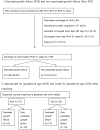Prediction of Postnatal Growth Failure among Very Low Birth Weight Infants
- PMID: 29487306
- PMCID: PMC5829148
- DOI: 10.1038/s41598-018-21647-9
Prediction of Postnatal Growth Failure among Very Low Birth Weight Infants
Abstract
Postnatal growth failure (PGF) in preterm infants remains an important clinical issue. In this study, we analysed the incidence of PGF among very low birth weight (VLBW) infants and evaluated the risk factors for PGF based on the data of 2799 VLBW infants obtained from the Korean Neonatal Network database from 2013 to 2014. PGF was defined as a decrease in weight Z score between birth and discharge of more than -1.28 using the Fenton growth charts. Risk factors were evaluated in relation to birth weight for gestational age, namely small (SGA) or appropriate (AGA) for gestational age, using propensity score matching used for between-group differences. The overall incidence of PGF was 45.5%, with a rate of 68.9% in the SGA group and 36.2% in the AGA group. PGF was negatively correlated with gestation and birth weight; additionally, PGF was associated with a higher incidence of co-morbidities. Predictors of PGF in the SGA group were respiratory distress syndrome and days to attain 100 mL/kg of enteral feeding. The only predictor of PGF in the AGA group was days to attain 100 mL/kg of enteral feeding. Early initiation and aggressive progression of enteral nutrition may decrease the incidence of PGF.
Conflict of interest statement
The authors declare no competing interests.
References
Publication types
MeSH terms
Substances
LinkOut - more resources
Full Text Sources
Other Literature Sources
Medical
Miscellaneous


